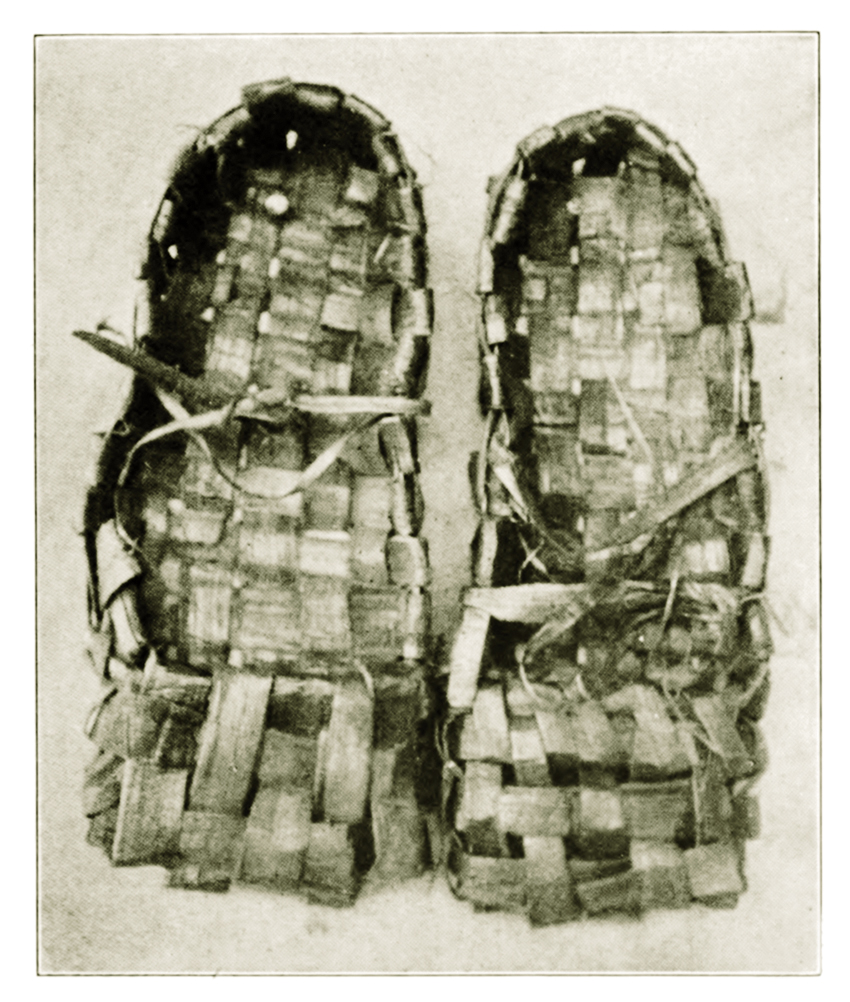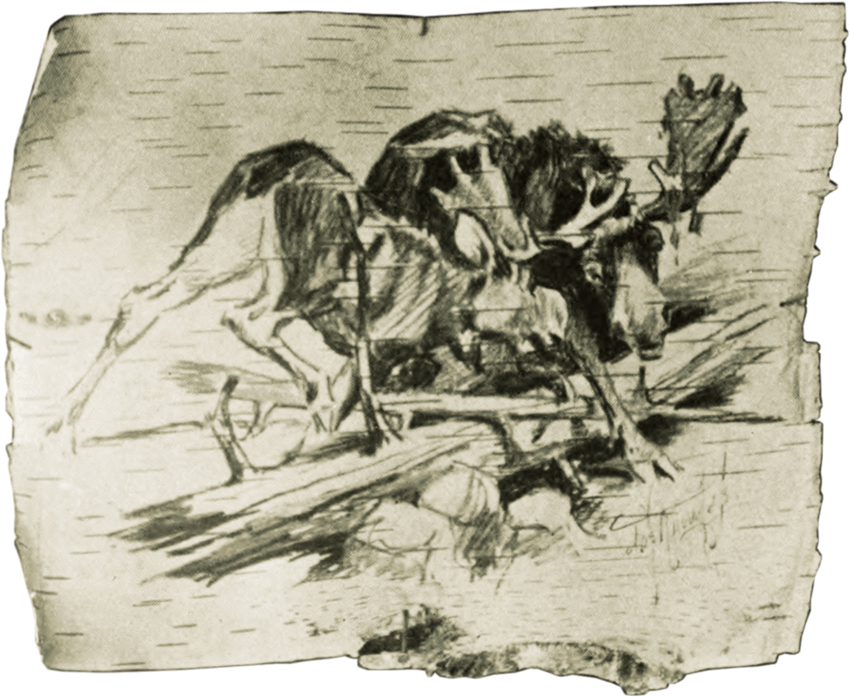Naked Joe

BREAKING NEWS: The Boston Post made the most of Knowles’s story in its pages. The paper got its information from dispatches that Knowles produced in the woods, by scribbling with charcoal on birch bark, and left for the paper in a pre-arranged dropoff spot.
Knowles was a nightmarish roommate for McKeogh during their time in the cabin—a hog who deprived McKeogh of life’s simplest pleasures. The worst of it came one day when McKeogh walked to the village of Eustis, 12 miles away, bought himself an apple pie, and carried it all the way back to the cabin. McKeogh placed it on the windowsill, to keep it cool overnight. The next morning, he heard the scuffling of feet behind him. He turned to see someone swiping the pie and trundling it off into the wilderness.
It was Joe Knowles. He ate the whole thing.
Nobody in Boston knew about this, of course. When Knowles finally returned to town, the city fathers embraced him as an emblem of virtue and hope. On October 11, an august assemblage—“a host of New England physicians, sportsmen, and professional men,” as the Post described it—honored Knowles with a black-tie banquet at the Copley Plaza Hotel. The gala was calibrated, it seems, to preempt naysayers and to sound hurrahs for a proud and growing city that had just opened the Franklin Park Zoo and was building its first real skyscraper, the 16-story Custom House Tower. The Honorable William A. Morse presided as emcee, and Dr. Samuel W. McComb, a psychologist, spoke, noting that Christopher Columbus had, much like Knowles, faced doubt after discovering the New World. “The world is full of skeptics,” McComb said. “However, I think we may disregard them all.” Soon, Dudley Sargent, Harvard’s physical-education guru, rose and argued, improbably, that the 45-year-old Knowles was stronger than Harvard’s hardest football men. “With his legs alone,” Sargent marveled, “he lifted more than 1,000 pounds.”
A few days later, Knowles went on the vaudeville circuit. He worked on his book. And then, late in 1914, he made it to Hollywood, where in his one film he rode horseback through the ostensibly Canadian woods, over snowdrifts and across raging rivers, as he was chased (and falsely accused of murder) by Canada’s North West Mounted Police. His mission was to save a beautiful starlet.
Knowles tried to get more movie gigs after that. A circa-1915 publicity shot shows him pitching himself as a heartthrob. Sitting on some porch steps in a fringed buckskin suit, he stares pouty-faced at the camera, his dreamy eyes filled with pained long-ing. Perhaps he was shilling for his own screenplay, The Poacher, an undated drama that was, as he himself described it, “a story of outdoor life in the game country of the Canadian Northwest.” The screenplay lists Joe Knowles in the starring role.
Knowles’s movie career went nowhere. But in time, after settling on Washington state’s Long Beach Peninsula in 1917, he would reinvent himself and find celebrity once again, as the illustrator of schlocky, canned images celebrating the American West. Knowles’s drawings and paintings of Indians, shipwrecks, and animals were so popular that when his pet chipmunk, Mr. Peabody, died in 1939, the Oregonian ran an obituary. Knowles, the newspaper noted, habitually fed Mr. Peabody fresh green beans.
With humans, though, Knowles seems to have been less endearing. In his memoirs, he dismisses his working-class neighbors in Long Beach, saying, “The natives do not interest me. They do not understand me, but I understand them, and they do not know it.”
Joe Knowles died in 1942. All of the 200,000 people who gathered at North Station to greet him are now probably dead, too, and his book is available in only a few libraries. A biography of Knowles, Naked in the Woods, by Jim Motavalli, appeared in 2008, but on the whole, this common man’s hero has in death met a common man’s fate: He has been forgotten. Or almost.
Today the world’s most important repository of Joe Knowles material, arguably, is the Long Beach Peninsula Trading Post, a rambly antiques shop where, amid old postcards and license plates, there’s a little shrine to Knowles—a glass case displaying several of his etchings, as well as a few yellowing manila folders containing his memoirs.
Last fall, I traveled up to the Trading Post from my home in Oregon, a couple of hours away. I went as a pilgrim. In poring over the dusty troves of old news clippings, I’d developed a warm appreciation for Knowles. He was a dyspeptic coot and a hard drinker, I can’t deny that. He had no stage presence, and he was a liar. But by my lights he was still an American hero. He was like the Great Gatsby. He had chutzpah and grandiose ambitions, and in his own bumbling way he chased after his dreams.
I visited the Trading Post on a sunny Saturday morning, where, lounging on a couch, I leafed through the last musty remains of Joe Knowles. I read of a skirmish Knowles had late in life with an aging neighbor. In a long letter to his lawyer, he alleged that 65-year-old Hatty Harmon tried to poison him so as to take possession of his home, and called her an “old witch” and an “old harlot.” In his unpublished memoirs, under the heading “Passing Thoughts,” he set down what could be construed as his closing argument. “Life is a queer game,” he wrote. “Cheat a little here, bluff a little there, smile when it hurts, hide the truth, grab what you can while the grabbing is good, hold what you have. If you play the game according to these rules, you will win materially.”
Later, across the street, 94-year-old Adelle Beechey told me she remembered Knowles as a “free thinker.” During the Depression, she said, he bought a car, even though he owed money at the local grocery store, and then took some friends out for a drive. “His friends were nervous because, of course, he imbibed a bit,” she told me. “And when they came to a railroad crossing and found a train coming, Joe just kept driving. ‘Don’t worry,’ he said. ‘She’s fully covered by insurance.’”
In the end, I wanted to have my own moment with Joe Knowles, so I drove into the village of Ilwaco, parked my car, and walked down toward the beach. For the last two decades of his life, Knowles resided there, in what Motavalli calls a “crooked cabin made of driftwood.” But that cabin vanished long ago, and even the topography of the place has shifted. The bluffs and fishing rocks that Joe Knowles walked by every day are now mostly erased. So I just strolled alongside the ocean as beachgoers flew kites and built sandcastles nearby. The sun was still high in the sky. It felt warm and good on my back, and I watched as its slanting light played tricks on the water.
Photo Album

Game wardens escort Joe Knowles back to civilization on the day he emerged from the wilderness.

Harvard’s Dr. Dudley Sargent examines Knowles not long afterward.

A lean-to left behind in the woods by Knowles.

Crowds gather in Boston to cheer Knowles on during his triumphant return to civilization.

Knowles greets his mother at the end of his long ordeal.

A pair of shoes fashioned by Knowles out of cedar bark.

One of the birch-bark dispatches, written in charcoal, that Knowles left in the woods for the Boston Post to collect.
The Birch Drawings
Knowles deployed his talents as an illustrator to sketch scenes from the wilderness, drawing with the tips of burnt sticks on scraps of birch bark.





